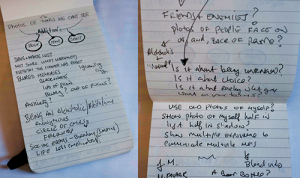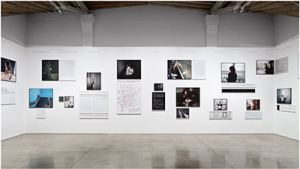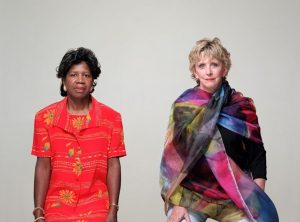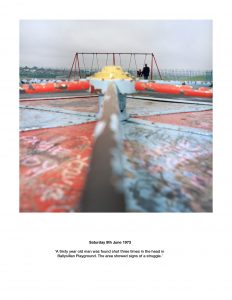Assignment Two: Write Up
Photographing the unseen
Start by doing some reflecting in your learning log. What kinds of subjects might be seen as un-photographable? How might you go about portraying them using photography? List a few examples of things you’re experiencing now or have recently been thinking about. This doesn’t have to be too in-depth or revealing, but it can be if you want. Equally, it might be something as apparently trivial as how you’re going to fit everything into your busy day. At first you may come up with literal examples, but the more you think about them the more those ideas will develop into specific and more original ones. Make a list of at least seven ideas. Try and keep to things you have a personal interest in or curiosity about.
Keep a notebook with you at all times and make notes when ideas strike you as interesting. (This is good practice for all stages of the degree and beyond. Ideas books are something to be revisited time and again for ideas and hints for the photographer you’re becoming.)
Now implement one of your ideas. Aim for a tightly edited and visually consistent series of 7–10 photographs.
Preparation work
Thinking about subjects that might be seen as un-photographable shifted me further away from approaching photography based on technical efficiency and the ubiquitous ‘decisive moment’ to expressing, communicating and exploring subjects that required more than just the photograph. In his book ‘Understanding a Photograph’ John Berger observes:
‘ …as soon as a photograph is used as a means of communication, the nature of lived experience is involved, and the truth becomes more complex…
And so as I began to think about ideas for the un-photographable I felt that images on their own was not going to be enough-I considered context, narrative, and using whatever else to help communicate meaning.
My first attempt to communicate the un-photgraphable was in assignment 3 EYV where I explored remembrance and the lengths we go to maintain connections to keep memories alive after people die. I photographed graves and the memorabilia people leave  on them to remember and celebrate the people who have died. Part of that series was also about what this told us about the people, their lives, who they were, what they were like. (In that series I tried to let the photos speak for themselves but it only partly worked)
on them to remember and celebrate the people who have died. Part of that series was also about what this told us about the people, their lives, who they were, what they were like. (In that series I tried to let the photos speak for themselves but it only partly worked)
As I began to think about the assignment, and subjects that might be portrayed in a series of images, I reflected on how much a photograph cannot tell us, how malleable it can be both in the hands of the taker and the viewer. I would need to consider that gap between the image itself, the title (or narrative) and the viewer, as well as the ‘tools’ at my disposal -the camera and images for sure, but what about video?, spoken word? input from others? image manipulation?
As suggested in the course, I began to keep a small notebook (a great and indispensable habit) to record my ideas and things that sparked inspiration. Some of my initial thoughts included:
- Alcoholism / Sobriety / Addiction- my personal experience from the condition of Alcholism- what do the concepts of alcoholism and sobriety mean? What does addiction feel like? What does sobriety feel like? I thought about a series or hommage to Julie Moos and specifically her series ‘Domestics’-could I do something similar about alchoholics? What doe san alcoholic look like anyway?
- Emotional conditions-anxiety, depression- I know people who have, and continue to suffer from anxiety and depression-how do you photograph something that complex without resorting to cliché?
- Anonymity-a key part of alcoholic recovery is anonymity-not because people are ashamed but because we need to treat all people the same and be non-judgemental-how to show anonymity but be in plain sight?
- Prejudice, unconscious bias-how to communicate something that is inside someones head?-but how did it get there? what conditions allowed it?
- Sleep-we often enter a dream world when asleep (partly anyway) or oblivion-what does that look like? dark?, Bright? Moody? Psychadelic? What are the elements of sleep?-bed, sheets etc.
- Inanimate emotion. Clothes mannequins – ubiquitous and almost invisible -its seems they exist on the periphery of our consciousness when we shop, but they are everywhere in fashion stores-what emotion if any do they convey?
Unlike other assignments that I’ve done where I’ve developed a rough idea of my subject matter and then proceeded to photograph and let the creative process unravel, this one was more planned and I gave a lot of thought to the media I would use to express my vision. My camera became a tool rather than the center-point of the assignment, as I had a lot more elements to consider, media types, narrative, input from other sources.
I was partly inspired by the work of other artists including:
Sophie Calle-Take Care of Yourself
In her work ‘Take Care of Yourself’ Sophie Calle orchestrated responses from women for many different walks of life to a break-up email she received from her then boy-friend. Obviously hurting she turned to her craft to help her make meaning of the email receiving all sorts of interpretations on all types of media and collected them in to a series. Her use of other people’s input resonated with me and was a bit of an ‘a hah’ moment where I realised I could broaden my pallet in regards to the different ways of communicating an idea.
Obviously hurting she turned to her craft to help her make meaning of the email receiving all sorts of interpretations on all types of media and collected them in to a series. Her use of other people’s input resonated with me and was a bit of an ‘a hah’ moment where I realised I could broaden my pallet in regards to the different ways of communicating an idea.
Julie Moos Friend and Enemies and Domestics
 Julie Moos shot the series ‘Friends and Enemies’ at the Altamont School in Birmingham, Alabama in response shootings at Columbine High School in Colorado in April 1999. She spent time at the school observing and interviewing students teachers and guidance counselors. When making the images, she made sure the the students didn’t know with whom they would be paired until the last moment and when viewing the images, the viewer also doesn’t know who if the couple photographed are best friends or enemies.
Julie Moos shot the series ‘Friends and Enemies’ at the Altamont School in Birmingham, Alabama in response shootings at Columbine High School in Colorado in April 1999. She spent time at the school observing and interviewing students teachers and guidance counselors. When making the images, she made sure the the students didn’t know with whom they would be paired until the last moment and when viewing the images, the viewer also doesn’t know who if the couple photographed are best friends or enemies.
What interested me about this series (and the similar ‘Domestics’) was the judgement the viewer manufactured from both a life of experiences and looking at the individuals on show-how they look and dress, and the challenge we have to see the equality in all people. The very name of the series,’Friends and Enemies’ acts as both an anchor (in that it wants to control and communicate a type of meaning) but also relays meanings as there is ambiguity within the images as the words ‘Friend’ and ‘Enemy’ bounce back and forth between the subjects and the viewer. The same applies to ‘Domestics’-which one is the hired help? -its a great exercise in unleashing your inner-prejudice (for this viewer) and how quick we are in making judgement by appearances alone.
Paul Seawright
 Irish artist Paul Seawright’s work ‘Sectarian Murders’ revisits the scenes of sectarian crimes as they are today and each image has an extract from news report from the time they were committed.
Irish artist Paul Seawright’s work ‘Sectarian Murders’ revisits the scenes of sectarian crimes as they are today and each image has an extract from news report from the time they were committed.
In one example the extract from the newspaper (written below the image of the scene as it is today) read (see photo to the right):
‘a sixty year old man was found shot 3 times in the head in Ballysillin Playground. The area showed signs of a struggle.’
As Seawright explains:
‘and the way the work functions really is that there’s a triangulation of the image- its the text, and the third element is when you put those things together the space between the text and the image is where you imagine the violence. And I think that’s much more powerful than the kind of immediate closure you get from the photograph of the crime scene with the body.’
What inspires and interests me about this work is that triangulation of the image, text and what he describes as the space between text and image. It was indeed very powerful trying to fill in the horrors that had happened in what appear (today) to be very normal, mundane and banal places-but its the narrative and the photos together that lend them power and added meaning.
The Series: Alcoholic Anonymity
Anonymity sits at the heart of AA to protect its members and foster equality, but it’s also a response to the stigma attached to alcoholism, personal and complex.
This series of images explores Alcoholic anonymity. It also touches upon addiction (obviously), fellowship and the challenges of anonymity.
Some of the images were taken by the subjects themselves (they are scattered around the world) and the words are a mixture of serendipitous finds and comments from the subjects-my brief was simple-what does anonymity mean to you and take a picture of yourself-face on, face hidden-your call.
Background
In 1992 I decided to quit drinking. I owned a pub and business was declining (after some incredible years), it seemed the party was well and truly over. I was not in a good place and decided to get help. This led me to AA and the rest, as they say, is history.
I was lucky.
I met a group of people who helped me get sober, took time out of their lives to sort me out and put up with my nonsense. Their collective and individual acts of kindness, perseverance and acceptance of who I was, helped me get and remain clean.
I’m still friends with many of those people and they too have managed to stay sober for well over twenty five years.
All those wonderful miracles.
Today we are happier in our skins, but the condition remains.
Self analysis
I found this series challenging but rewarding. Obviously, I have a personal interest and intimate experience in the topic explored and this gave me plenty to dip into. I used wider pallet of sources and media and found using them takes time and consideration. The images were no longer centre stage in terms of being ‘decisive moments’ or documents of truth, and I played with its malleability by choosing words that nudged or challenged the viewer to think about the space in-between the narrative and the image. I tried also to get a visual consistency across the series by producing them in black and white and cropping them to a 1 x 1 aspect ratio.
The key theme running through the series is anonymity which starts at the beginning, is punctuated hallway through before a final reveal at the end. For me these three images hold the series together and provide a parallel narrative-one of breaking or revealing my anonymity when I please, sometimes in frustration/anger, sometimes to be practical, sometimes to help others.
I found taking phots of myself very uncomfortable but at the same time felt a sense of defiance. As I worked through the series, I came to realise I actually harbor a lot of frustration about having to be anonymous and pander to peoples bias-conscious/unconscious or otherwise.
Does the series work?
In parts it does, some images work well on their own ( 1, 4,8) and during the editing and selecting I found myself leaning towards doing a fuller and deeper exploration of anonymity-but many of the people I wanted to include are scattered around the globe and it would have taken too long.
I am unsure about image 3-both the image and the narrative. I had an alternative narrative which read: The is no real mystery-just a group of like minded people who want to change their lives, but went for the anecdote
I also thought about the final image and whether I should just have an image of myself and not a double exposure-the idea here is that I am both these people, but the single image works just as well I think.
Overall it works in parts but ultimately its what viewers take away from it.
Arrangement
I felt empowered using other peoples input and working it into a narrative. For this series (after feedback from my tutor) I intend to print each photo and mount on an A3 white board with the narrative center left. The sequence would be as presented but horizontally.
Further development
While doing this series I began to think about the anonymity aspect of being an alcoholic and the stigma attached to the word if not the person. Tell a person you are an alcoholic, and they begin to look at you differently, they get uncomfortable-especially if it’s a social setting. Not always but most times. Ive had colleagues not invite me to the pub presumably non-drinkers can’t enjoy themselves.
My development for this series would be to redo it using the same technique Julie Moos used in ‘Domestics’. I would photograph people in pairs (or more-three max), some would be alcoholics, some not, I would leave the viewer to decide.
I would include all of the subject in the shot for the viewer to apply his/her/their full arsenal of prejudice and social influences.
I would also ask people to cast their vote as to who they think is an alcoholic.
Twenty six seems to be a sacred number in photography (a nod and thanks to Ed Ruscha), so I would honour that and have 26 images in the series.
I would also have other alcoholics take the photographs and source them from the many contacts I have scattered around the world.
————————————————————————————————————————————————-
Reflection post tutor feedback
Taking the feedback from my tutor onboard I reworked the titles of the images and replaced some to make the narrative flow better. A key learning from this series has been around the interplay between titles and images; as my tutor explained,
‘there always the danger that text will swamp the narrative within the images and will not allow the viewer an independence of interpretation when viewing the work’
and from this, I realised I was trying to control the narrative too tightly. For the reworked series I decided to title the series ‘My Worst Days sober are Better than my Best Drinking Days’ and leave each photo untitled. I did this so as to leave the viewer to work with the images and interpret them according to their worldview.
I considered the point my tutor made about Barthes ‘Death of an Author’,
‘This project has the potential for further development into many of the issues underlining attitudes to addiction. The association of good times, the romanticised view of alcoholic creatives without reference to the destruction of their talent. Although to some people this becomes part of the myth but perhaps it lends some weight to Barthe’s concept of the death of the author. Look, read and listen to the work. Do Behan’s plays, Hemingway’s novels or Thomas’s poems read better if we know of their personal addictions?
Although Barthes makes some valid points which took me a few attempts to understand, I did feel I had a big ‘so what’ at the end of it. People do bring their own worldview to everything, use and reuse pre-existing concepts but it’s exactly this that resonates with readers and or viewers of works of art. When I read ‘Dubliners’ by James Joyce I get a totally different experience (I’m from Dublin-its culture is in my blood) than someone who has never been to Dublin-and that’s ok-if Joyce hadn’t put the word together or as Barthes says, a tissue of quotations and signs’ we would be the poorer for it. I do agree when he says the meaning of a text is ‘not in its origin but in its destination’ and taking my tutor’s question into account regarding some famous authors,
‘do Behan’s plays, Hemingway’s novels or Thomas’s poems read better if we know of their personal addictions?’
I’d say they give us a context which does lead to a different reading of their works. It’s different rather than better.
Regarding many images, what this begins to tell me is that the interpretation of my images is malleable and fluid and driven by the interplay between the image, text (if any) and the viewers’ worldview, experience, and the context within which the images are shown e.g. a well-known gallery or a students OCA blog!
References
Alcoholics Anonymous.org http://www.alcoholics-anonymous.org.uk/download/1/PDFs/The%20Big%20Book/theylostnearlyall3.pdf (Accessed Feb 5th 2022)
Barthes, Roland, Death of an Author, https://sites.tufts.edu/english292b/files/2012/01/Barthes-The-Death-of-the-Author.pdf (accessed 05/03/2022)
Berger, John (2013) Understanding a photograph, London, Penguin Group pp66-71
Edwards, Steve, (2006) Photography, A Very Short Introduction,Oxford, Oxford University Press
Photo 4 Greenway, J, Intagram Post https://www.instagram.com/p/CZt0OR4Kc0z/. (Accessed 15/02/2022)
photo 2 Myers, Scott, 2014, Script to Screen: “No Country For Old Men” https://gointothestory.blcklst.com/script-to-screen-no-country-for-old-men-163bc6656999 (Accessed Feb 18th 2022)
Seawright, Paul, Things Left Unsaid – in conversation with Donovan Wylie (https://vimeo.com/134925293-accessed 10/08/2021)
Waters, Roger (1983) The Final Cut, (https://www.google.com/search?q=lyrics+final+cut+pink+floyd&oq=lyrics&aqs=chrome.1.69i57j69i59j0i512j0i433i512j0i131i433i512j0i512l2j0i433i512j0i512l2.4552j0j7&sourceid=chrome&ie=UTF-8)

